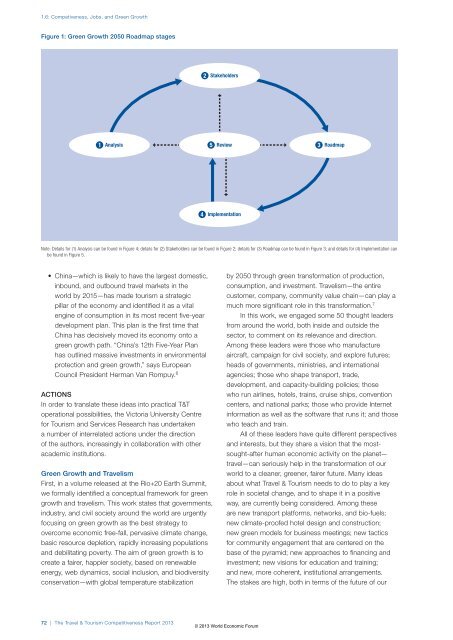The Travel & Tourism Competitiveness Report 2013
The Travel & Tourism Competitiveness Report 2013
The Travel & Tourism Competitiveness Report 2013
Create successful ePaper yourself
Turn your PDF publications into a flip-book with our unique Google optimized e-Paper software.
1.6: Competiveness, Jobs, and Green Growth<br />
Figure 1: Green Growth 2050 Roadmap stages<br />
Analysis<br />
• China—which is likely to have the largest domestic,<br />
inbound, and outbound travel markets in the<br />
world by 2015—has made tourism a strategic<br />
pillar of the economy and identified it as a vital<br />
engine of consumption in its most recent five-year<br />
development plan. This plan is the first time that<br />
China has decisively moved its economy onto a<br />
green growth path. “China’s 12th Five-Year Plan<br />
has outlined massive investments in environmental<br />
protection and green growth,” says European<br />
Council President Herman Van Rompuy. 6<br />
ACTIONS<br />
In order to translate these ideas into practical T&T<br />
operational possibilities, the Victoria University Centre<br />
for <strong>Tourism</strong> and Services Research has undertaken<br />
a number of interrelated actions under the direction<br />
of the authors, increasingly in collaboration with other<br />
academic institutions.<br />
Green Growth and <strong>Travel</strong>ism<br />
First, in a volume released at the Rio+20 Earth Summit,<br />
we formally identified a conceptual framework for green<br />
growth and travelism. This work states that governments,<br />
industry, and civil society around the world are urgently<br />
focusing on green growth as the best strategy to<br />
overcome economic free-fall, pervasive climate change,<br />
basic resource depletion, rapidly increasing populations<br />
and debilitating poverty. <strong>The</strong> aim of green growth is to<br />
create a fairer, happier society, based on renewable<br />
energy, web dynamics, social inclusion, and biodiversity<br />
conservation—with global temperature stabilization<br />
72 | <strong>The</strong> <strong>Travel</strong> & <strong>Tourism</strong> <strong>Competitiveness</strong> <strong>Report</strong> <strong>2013</strong><br />
Stakeholders<br />
Review<br />
Implementation<br />
Roadmap<br />
Note: Details for (1) Analysis can be found in Figure 4; details for (2) Stakeholders can be found in Figure 2; details for (3) Roadmap can be found in Figure 3; and details for (4) Implementation can<br />
be found in Figure 5.<br />
by 2050 through green transformation of production,<br />
consumption, and investment. <strong>Travel</strong>ism—the entire<br />
customer, company, community value chain—can play a<br />
much more significant role in this transformation. 7<br />
In this work, we engaged some 50 thought leaders<br />
from around the world, both inside and outside the<br />
sector, to comment on its relevance and direction.<br />
Among these leaders were those who manufacture<br />
aircraft, campaign for civil society, and explore futures;<br />
heads of governments, ministries, and international<br />
agencies; those who shape transport, trade,<br />
development, and capacity-building policies; those<br />
who run airlines, hotels, trains, cruise ships, convention<br />
centers, and national parks; those who provide Internet<br />
information as well as the software that runs it; and those<br />
who teach and train.<br />
All of these leaders have quite different perspectives<br />
and interests, but they share a vision that the mostsought-after<br />
human economic activity on the planet—<br />
travel—can seriously help in the transformation of our<br />
world to a cleaner, greener, fairer future. Many ideas<br />
about what <strong>Travel</strong> & <strong>Tourism</strong> needs to do to play a key<br />
role in societal change, and to shape it in a positive<br />
way, are currently being considered. Among these<br />
are new transport platforms, networks, and bio-fuels;<br />
new climate-proofed hotel design and construction;<br />
new green models for business meetings; new tactics<br />
for community engagement that are centered on the<br />
base of the pyramid; new approaches to financing and<br />
investment; new visions for education and training;<br />
and new, more coherent, institutional arrangements.<br />
<strong>The</strong> stakes are high, both in terms of the future of our<br />
© <strong>2013</strong> World Economic Forum

















